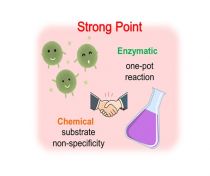Chemo-enzymatic amide synthesis

- researcher's name
- affiliation
- research field
-
Functional biochemistry
- keyword
-
background
● Amide compounds are useful material for food, cosmetics, pharmaceuticals.
● Chemical method requires multi-step reaction and generates a lot of waste.
● Enzymatic method limits the kinds of amide to synthesize.
● Chemical method requires multi-step reaction and generates a lot of waste.
● Enzymatic method limits the kinds of amide to synthesize.
summary
● A novel chemo-enzymatic reaction for the amide synthesis.
❍ Enzymatic reaction: activation of the carboxyl group of the substrate.
❍ Chemical reaction: nucleophilic substitution reaction to be various amides.
❍ Enzymatic reaction: activation of the carboxyl group of the substrate.
❍ Chemical reaction: nucleophilic substitution reaction to be various amides.
predominance
● Hybrid reaction produces amide compounds by one-pot reaction.
● Reaction proceeds under mild condition without special equipment.
● More amides can be synthesized compared to conventional method.
● Reaction proceeds under mild condition without special equipment.
● More amides can be synthesized compared to conventional method.
application/development
● Amide compounds for pharmaceuticals, prodrugs or chemicals.
● Dipeptides for functional food, supplements or materials.
● Fatty acid amides for surfactants.
● Dipeptides for functional food, supplements or materials.
● Fatty acid amides for surfactants.
same researcher's seeds
posted:
2018/11/29






